Tower cranes technical characteristics table. Main characteristics of tower cranes
This group includes unified cranes KB-403A, KB-403B, KB-405.1A, KB-411, KB-408, crane modular system KBM-401 and their modifications. These cranes with a maximum lifting capacity of 8 ... 10 t are designed for construction and installation works on the construction of residential, civil and industrial buildings and structures up to 12 ... 16 floors high, have the same design and are mobile self-propelled full-revolving machines on a rail track with a rotary telescopic tower and a lower counterweight arrangement.
The technical characteristics of cranes of the 4th size group are given in table. 2.
Cranes of the modular system KBM-401P have basic unified modules (mechanisms, cab, slewing support, sections of towers and booms). At the same time, the mechanisms, the cabin, the slewing ring are tied across the entire standard size range, and the metal structures of the cranes - for all versions within this standard size. By varying the number of modules of sections of towers and booms, it is possible to obtain different versions of the crane from the same unit-modules, differing in cargo, speed and height characteristics, reach and type of boom (Table 1).
The version of the KBM-401P crane (Fig. 1) can be used in warehouses, landfills and transfer sites. The cranes are designed to operate in I-VI wind regions at an ambient temperature of -40 ... + 40 ° C.
Rice. 1. Tower crane of the KBM-401P modular system (numbers in circles - numbers of versions): a - versions with a beam boom; b - versions with a lifting boom
KB-405.1A cranes and five versions of the KBM-401P crane are equipped with a lifting jib, KB-403A, KB-403B, KB-408 cranes and 28 versions of the KBM-401P crane (including base model) - a beam boom with a load trolley.
Table 1. Technical characteristics of the KBM-401P tower crane versions of the Rzhevsky Crane Building Plant
Execution number |
Options |
|||||||
Cargo moment, kN - m |
Maximum lifting capacity, t |
Maximum lifting height, m |
Maximum outreach, m |
Departure at maximum carrying capacity, m |
Carrying capacity at maximum outreach, t |
Number of tower sections |
||
Horizontal boom H 1 |
Oblique boom(? = 30 °) H 2 |
|||||||
The constituent parts of each crane (Fig. 2) are: an annular running frame 1 of a box section, a single-row roller slewing support 16 with internal gearing, a turntable 2, a portal 15, a tower 14, a head 7, an arrow 11, a cargo trolley 9 ( for cranes with beam boom), cargo 6 and jib 5 ropes, bracing 8, hook suspension 10, mounting device, unified driver's cab 13 and working mechanisms, counterweight 3, electrical equipment, safety devices and cable drum... Four swivel weather vanes are pivotally connected to the chassis and positioned diagonally by means of tubular struts. Each weather vane rests on a unified balancing two-wheeled undercarriage 17 with a lifting capacity of 72 tons for KBM-401 and KB-408 and 60 tons for the rest of the group's cranes. All bogies of the KBM-401 crane are driving (leading). For other cranes, the bogie set includes two driving and two driven bogies, with the driving bogies being located on one rail.
When the track is rounded with a radius of the inner rail of 7 ... 10 m, the leading bogies are located on the outer rail, with a radius of the inner rail of more than 10 m, they can be placed on any rail. The trolleys are supported on P50 crane rails. The track and base of the cranes of the fourth size group, as a rule, are equal to 6 m. A rotary platform is supported on the chassis through the swing support, on which the cargo and boom winches, swing mechanism, electrical cabinets, and counterweight plates are installed. In the front part of the turntable, the tower portal is hinged by means of brackets.
Lattice crane towers consist of a head, an upper section, intermediate sections, a portal and a movable frame. Towers grow from below with intermediate sections as the building is erected. For growing the intermediate sections of the tower is used linkage cage extension (mounting parallelogram), mounted in front of the platform. In the vertical position, the towers are held by two telescopic struts 4. The portal consists of two triangular trusses connected in two tiers by box beams. On the gantry belts, guide rollers are mounted that hold the tower in a vertical position when it is extended. In the upper tier, four locks are installed on the beams, the purpose of which is for the tower to land on them after its extension. The fixed blocks of the upper tier of the portal, together with the blocks of the movable cage and the assembly rope, form the assembly chain hoist for the extension of the crane tower. When extending the tower, one end of the assembly rope is fastened in top harness portal, the other is fixed on the drum of the cargo winch, from which the cargo rope is removed. The head of the tower consists of a metal structure, spacers with a rope guy and a mounting rack with a guy for lifting the boom to the working position. On top of the head there are two blocks of the boom brace and blocks of the cargo mat. Beam booms of KB-403A, KB-403B, KB-408, KBM-401 cranes are single-suspended, sectional, made in the form of a triangular truss, along the lower chords of which a cargo trolley moves. The movement of the cargo trolley is carried out by a trolley winch 12, installed at the root of the boom, and a trolley rope. With the help of a boom winch and a boom chain hoist, the boom can be set in a horizontal or inclined (at an angle of 30 ° to the horizontal) position.
Rice. 2. Cranes of the KB series of the 4th size group: a - KB-403B; b - KB-401.5A
All cranes with a girder boom (except for the KB-403A crane) have the ability to move a load trolley with a load along an inclined boom. At the same time, thanks to a special reserve of the cargo rope, the load moves almost horizontally when the departure changes, which facilitates the guidance of the load, reduces the duration of the working cycle and contributes to an increase in the productivity of the crane. Changing the rope reserve from horizontal to inclined boom is carried out automatically. The load carts are equipped with devices for their automatic locking when the bogie rope breaks.
The lifting boom of the KB-405.1A crane is lattice, triangular section, made of pipes: lifting and lowering of the boom when the outreach is changed is carried out by a boom winch through a boom-lifting chain hoist. In the root section of the boom, a strut with rope rods is suspended from below, which protects the boom from tipping over when the rope breaks at minimum overhangs.
Crane ropes storage diagrams are shown in Fig. 3. The load characteristics of the cranes are shown in Fig. 4.
Rice. 3. Schemes for reserving ropes of cranes of the 4th size group: a - a cargo rope with a lifting boom; b - a cargo rope of cranes with a beam boom; in - boom rope; g - bogie rope; d - assembly rope; 1 - cargo winch; 2 - cargo rope; 3 - boom rope; 4 - boom winch; 5 - trolley winch; 6 - bogie rope; 7- cargo trolley; 8 - portal block; 9 - assembly rope; 10 - block of a movable holder
Rice. 4. Cargo characteristics of cranes of the 4th size group: a - crane KB-408.21: l - with a horizontal boom; ll - with an inclined boom; b - KB-405.1A
The unified crane mechanisms (Fig. 12) include boom, cargo and trolley winches, slewing support and movement mechanism.
The cranes are equipped with one - and two - engine cargo winches (Fig. 5, a, b). The main electric motor of the twin-engine winch is designed for lifting (lowering) loads of the largest mass, the auxiliary one - for lifting (lowering) loads of the smallest mass, hook suspension and ensuring the landing speed.
The KB-408 crane versions are equipped with: twin-engine cargo winches with motors alternating current(main motor with a wound rotor, auxiliary - with a squirrel-cage), single-motor winches equipped with an alternating current electric motor with a wound rotor and a brake machine or electric motor direct current with thyristor converter. The use of a thyristor DC electric drive allows you to expand the range of speed control when lifting and lowering a load of maximum weight, significantly increase the speed of lifting small-weight loads and an empty hook.
Rice. 5. Kinematic diagrams of unified mechanisms of cranes of the 4th dimensional group: a, b - cargo winch; in - boom winch; d - trolley winch; d - turning mechanism; e - movement mechanism; 1 - two-stage gearbox; 2.8 - brakes; 3, 4 - electric motors; 5 - trolley winch; 6 - cylindrical gear; 7- globoid gearbox; 9 - three-stage gearbox; 10 - a gear wreath; 11 - output gear; 12, 13 - gears; 14 - running wheel
Each version of the KBM-401 crane can have three modifications of the cargo winch drive - with two AC motors, with two AC motors and a switchable gearbox, with a DC motor and a thyristor converter.
Boom winches (Fig. 5, c) differ from cargo winches by the absence of an auxiliary engine. The trolley winch (Fig. 5, d) consists of an electric motor, a shoe brake, a gearbox including a cylindrical and globoid transmission, and a rifled drum. Disconnection of the winch drive in the extreme positions of the trolley is carried out by a limit switch.
The swing mechanism (Fig. 5, e) consists of a vertical three-stage gearbox of a flange electric motor and a special shoe brake. Braking is carried out in three stages: free braking, dynamic braking, final braking of the swing mechanism. Two swing mechanisms are installed on the KBM-401 crane and its versions. The mechanism for moving the cranes (Fig. 34, e) includes an electric motor, a gearbox (the same as that of a trolley winch), spur gears and traveling wheels.
Jib cranes of the KB-404.4 family are designed to perform construction and installation work during the construction of zero cycles of buildings in housing and civil engineering.
In the designs of KB-404.4 cranes, standardized units and mechanisms of serially produced tower cranes.
Component parts of the cranes: undercarriage with trolleys, slewing support, slewing platform with crane mechanisms installed on it, lifting boom, driver's cab, stand with strut and ballast. Sectional booms of cranes, rectangular section and consist of a root, head and three intermediate sections. Cranes can be assembled in versions that differ in boom length, lifting capacity and load moment. The KB-404.4 crane is equipped with a replaceable support insert that serves as a short tower, which makes it also suitable for the construction of low-rise buildings. From site to site, cranes are transported on a rolling cart using a truck tractor.
The technical characteristics of the KB-404.4 jib cranes are presented in table. 3.
Table 3. Technical characteristics of jib cranes for zero cycle
Options |
Machine index |
||
KB-404.4-1 |
KB-404.4-2 |
KB-404.4-3 |
|
|
Carrying capacity, t |
|||
|
Hook outreach, m |
|||
|
Hook lifting height, m: |
|||
|
without insert |
|||
|
with insert |
|||
|
Working speeds, m / min: |
|||
|
lifting load |
|||
|
smooth landing of cargo |
|||
|
crane movement |
|||
|
Rotation frequency, min -1 |
|||
|
Track x base, m |
|||
|
Installed power, kW |
|||
|
without insert |
|||
|
with insert |
|||
|
Manufacturer |
JSC "Karacharovsky Mechanical Plant" (Moscow) |
||
Specifications
Table 2. Technical characteristics of KB cranes of the 4th size group
Options |
Machine index |
||||||
KBM-401HL |
KB-403A |
KB-403B |
KB-403B.4 |
KB-405.1A |
KB-411-04 |
KB-408.21 |
|
|
Maximum load moment, kN m |
|||||||
|
Frequency rate of the cargo chain hoist |
|||||||
|
Carrying capacity, t: |
|||||||
|
at maximum departure |
|||||||
|
maximum |
|||||||
|
with a horizontal (inclined) boom: |
|||||||
|
maximum L 1 2) |
|||||||
|
at maximum lifting capacity: |
|||||||
|
minimum L 3, |
|||||||
|
with a lifting boom: |
|||||||
|
maximum L 1 |
|||||||
|
minimum L 2 |
|||||||
|
Hook lifting height, m: |
|||||||
|
the largest with a horizontal (inclined) boom H 1 (H 2) |
|||||||
|
the largest with a lifting boom: |
|||||||
|
at maximum departure H 1 |
|||||||
|
at minimum departure Н 2 |
|||||||
|
Lowering depth, m |
|||||||
|
Working speeds, m / min: |
|||||||
|
lifting load maximum height |
|||||||
|
smooth landing |
|||||||
|
movement of the cargo trolley |
|||||||
|
crane movement |
|||||||
|
Rotation frequency, min -1 |
|||||||
|
Track x base, m |
|||||||
|
The smallest radius of curvature of the path, m |
|||||||
|
Installed power, kW |
|||||||
|
constructive |
|||||||
|
counterweight |
|||||||
|
Manufacturer |
OJSC "Ukhta Mechanical Plant" (Komi Republic) |
OJSC "Nyazepetrovsk crane-building plant" (Chelyabinsk region, Nyazepetrovsk) |
JSC "Rzhevsky Crane Construction Plant" (Rzhev, Tver region) |
JSC "Karacharovsky Mechanical Plant" (Moscow) |
OJSC "Nezepetrovsky crane-building plant" |
||
The construction of civil and industrial buildings, the construction of residential multi-storey buildings, loading and unloading operations in warehouses, sites and landfills cannot be imagined without the use of tower cranes. They move loads, structural elements to the required point of the construction site.
Let's try to figure out what a tower crane is and find out its technical characteristics. The article will allow us to find out the parameters of tower cranes, their types and understand where, in what area, their application will be most effective. And also find out the price of the "one-armed assistant".
The speed of work is determined by the power and performance of the tower crane. The overall pace of construction and erection of buildings depends on its speed of movement and the weight that it can lift. The tower crane video, which can be seen in the below, is a cyclic type mechanism.
What is included in the concept of a cycle of operation of a mechanism:
- This is the seizure of the load.
- Moving the captured object.
- Unloading at the planned location.
- Reverse run.
| Tower crane specifications of this type, its capabilities | |||
| 1 | Tower crane height (boom reach) | meter | 40 |
| 2 | Possible boom lifting height with load | meter | 150 |
| 3 | Lifting speed | meter / min | 10 — 100 |
| 4 | Rotation of the crane structure (its frequency) | rpm | 0,2 – 1,0 |
| 5 | Travel speed | meter / min | 10 — 30 |
| 6 | Load capacity of the load mechanism with minimum boom outreach | Kg | 7500 |
Tower cranes the characteristics we are considering are of several types:
- With a swivel tower.
- And a non-rotating design.
The prefabricated version of the structures allows short time to carry out the installation and dismantling of the crane. Transfer it to the desired location. Speaking about tower cranes as a variety of lifting mechanisms, we add that the non-rotating tower is divided into three types:
- telescopic option;
- stackable structure;
- growing up.
Way to travel
To move around construction site install rails. Along them, the crane can move back and forth, lifting and delivering building structures or loads to the desired point on the construction site.
There is a category of cranes that rests on the outside of the facility under construction. This is classified as an attachment type design. In some cases, self-lifting mechanisms are used. With an increase in the height of the object under construction, they rise up.
There are, in addition to the cranes under consideration, mechanisms on pneumatic wheels. Cranes that move on tracks and mounted on vehicles.
Tower crane device
The design includes:
- support part;
- control cabin;
- slewing bearings;
- tower;
- arrow;
- running frames;
- a device for moving along curves;
- rotary platforms;
- stairs and platforms.
Tower crane brands
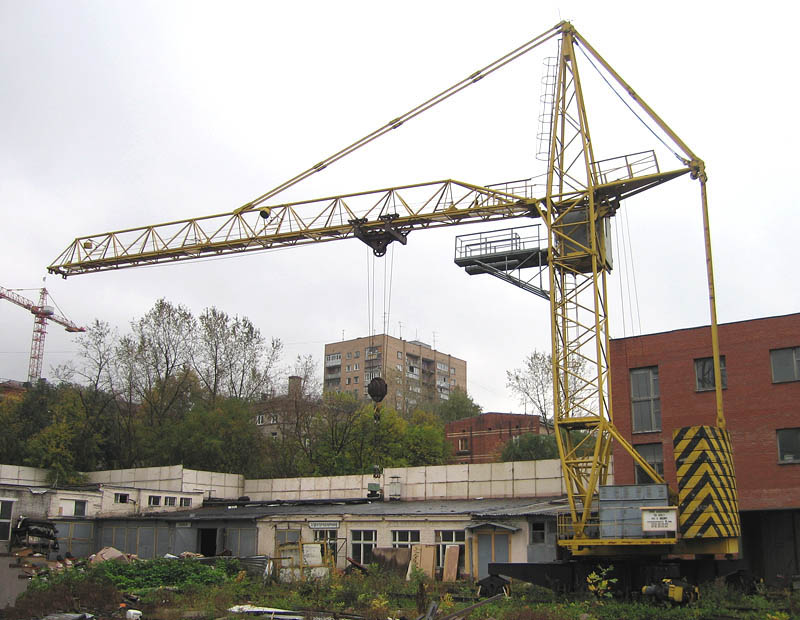
Today, many cranes are produced and are on construction sites. different brands... Photo tower cranes, which are presented at the end of the article, are most in demand. We are talking about the "KB" series. It is believed that this series with swivel cab most commonly found on construction sites. We will focus on them.
Technical characteristics of KB tower cranes
KB-100 is used in the construction of buildings with a height of 5 - 9 floors. Moves along the track. KB-100 is an installation with an inclined boom and a rotating turret. Lifting height from 21 to 33 meters. Lifting speed 43 m / s.
KB-402 rail-mounted crane with a rotating tower. It can lift loads up to 8000 kg. The boom reach is 25 meters. Used in the construction of five-story buildings.
How much does a tower crane cost?
A tower crane, the price of which depends on its performance, lifting capacity, year of manufacture and technical condition, can be purchased using credit funds. It is possible to lease or purchase used equipment. The breakdown is from 13,897,000.00 to 1,287,000.00 rubles. The average price of cranes in the Russian Federation is 670,000.00 rubles. the practice is to rent a crane for a certain period.
Suffice it to say that any cranes, regardless of lifting capacity, speed of movement, are a demanded tool, without which construction is impossible. high-rise buildings... Their use only speeds up the process of building buildings.
Crane "Pioneer" l / c 500, 750, 1000
General information
Manufacturers CJSC "Tverskoy Experimental Mechanical Plant"
OKP code 483580
Specifications
Carrying capacity, kg 500, 750, 1000
Technical characteristics Lifting height - 50 m, when installed on the ground 4, 5, 6 m. Lifting speed - 0.2; 0.14; 0.74 m / s. Drive power - 4.0; 4.0; 4.25 kW. dimensions 4.2 x 1.78 x 5.4 m; 4.28x1.7x5.4 m; 4.5 x 2.0 x 6.0 m. Weight without kg / g, kg - 480; 480; 900. Full weight, kg - 910; 921; 1790 kg. Rope diameter, mm - 6.9; 6.9; 12. Rope diameter, mm - 6.9; 6.9; 12
Application The "Pioneer" crane is designed for lifting loads with its installation on the ground and floors of buildings and structures. The crane is a collapsible design.
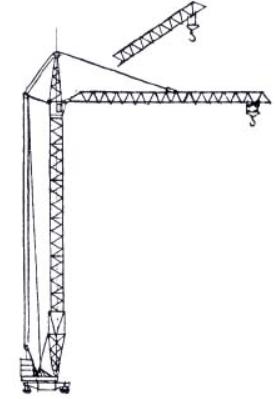
General information
Brand (type) KB - 403B
GOST, TU TU 22-5955-85
Weight, kg 80 500
OKP code 4835421101
Specifications
Carrying capacity, t 8
Technical characteristics Type - mobile on a rail track with a rotary tower and a beam boom. Load moment -120 tm. Height to the boom suspension axis - 43.6 m.Lift height at maximum reach, with a horizontal boom - 41m, with an inclined boom - 54.7 m.Maximum reach with a horizontal boom - 30 m, maximum with an inclined boom - 26.3 m , the smallest outreach is 5.6 m. The speed of lifting (lowering) the load is 40 (55) m / min. The speed of the smooth landing of the load is 5 m / min. Crane travel speed - 18 m / min. Installed capacity - 77.6 kW. Structural weight - 50.5 t
Application Designed for the mechanization of construction and installation work during the construction of residential and industrial buildings and structures with a mass of mounted elements up to 8 tons
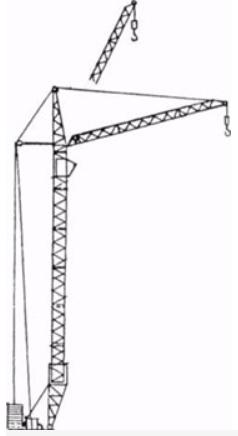
General information
Brand (type) KB - 405.2A
GOST, TU TU 22-03821-89
Weight, kg 114,000
OKP code 4835421030
Specifications
Carrying capacity (max.), T 9; with a minimum outreach of an arrow - 13
Technical characteristics Type - mobile on a rail track with a rotary tower and a lifting boom. Load moment - 162 tm. Maximum lifting height - 63.4 m, with a maximum outreach - 51.6 m. Maximum outreach - 25 m, minimum - 13 m, with a maximum lifting capacity - 18 t. Loading capacity with a maximum outreach of 25 m - 6.3 t. Track and base - 6 m. Power of electric motors during operation of two mechanisms - 45 kW. Ballast - 50 t
Application Designed for the mechanization of construction and installation works in the construction of multi-storey buildings with a mass of elements up to 9 tons.
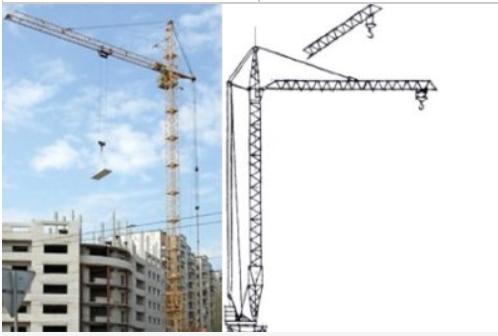
General information
Brand (type) KB - 408.21
GOST, TU TU 22-28005
Weight, kg 55 700
OKP code 4835421760
Specifications
Carrying capacity, t 10 with an outreach of an arrow of 5 m
Technical characteristics Maximum load moment - 200 tm. Lifting height (horizontal boom) - 54 m. Outreach of the horizontal boom - 30 m. Depth of lowering - 5 m. Turning angle - 1080 degrees. Seismicity, points 1-6 according to SNiP II-7-81
Application The tower crane is designed for the mechanization of construction and installation work in residential and civil construction of structures up to 72.7 meters high with a weight of mounted elements up to 10 tons. The KB-408.21 model is a construction mobile full-slewing rail-mounted crane with a slewing tower and a beam boom with a load trolley that provides vertical and horizontal transportation of construction parts and materials. The disassembled crane is transported from site to site. Installation is carried out by our own mechanisms and using a truck crane
Description Tower crane KB-408.21 is equipped with a cab heating system for operation in winter time... Manufactured in climatic performance Category V I according to GOST 15150-69 for areas with an ambient temperature of - 40 degrees. up to + 40 deg. C
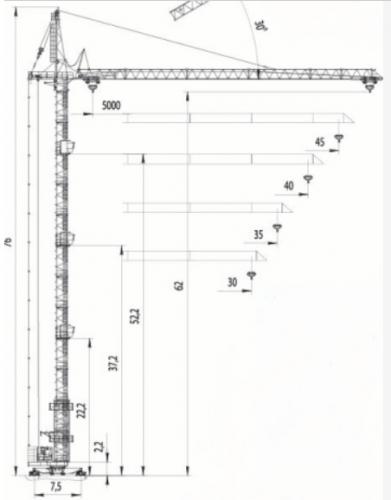
General information
Brand (type) KB - 415
Weight, kg 115 800
OKP code 45354210
Specifications
Carrying capacity, t 12
Technical characteristics Load moment - 160 tm. Carrying capacity at max. departure - 3.2 tons. Lifting capacity raised by 30 degrees. - 3.2 t. Departure of the boom - 40 m. Departure of the boom raised by 30 degrees. - 35 m. Structural weight - 67.8 tons. Counterweight on the turntable - 45.8 tons. Counterweight on the strut - 3 tons. Operating conditions from -40 to +40 degrees. Seismicity up to 6 points
Application KB-415 is intended for mechanization of work on the construction of buildings up to 83 m in height with a mass of mounted elements up to 10 tons.
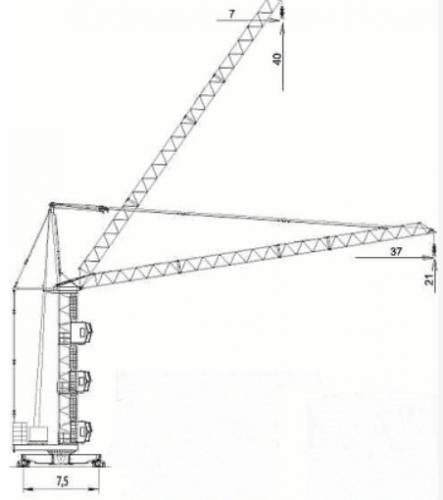
General information
Brand (type) KB - 415-07
Weight, kg 80 700
Manufacturers Kokhomskiy plant "Strommashina"
OKP code 45354210
Specifications
Carrying capacity, t 10
Technical characteristics Load moment - 250 tm. Carrying capacity at max. departure - 5 tons. Lifting capacity raised by 30 degrees. - 6 t. Boom outreach - 37 m. Minimum outreach - 7 m. Lift height - 40 m. Lowering depth - 5 m. Structural weight - 42.4 t. Counterweight on the turntable - 38.5 t. Operating conditions from -40 to +40 Grad. Seismicity up to 6 points
Application KB-415-07 is intended for the mechanization of work on the construction of buildings up to 40 m high, as well as for carrying out works of the zero construction cycle. Tower crane, bottom-slewing, with a luffing jib providing an outreach of up to 37 m
Description The crane has an upper tower build-up by means of hydraulic equipment of the mounting sleeve. Installation and dismantling of the crane is carried out with a downy boom with the possibility of connecting the boom sections during the installation process when working in cramped conditions. During construction, the driver's cab can be moved to fixed positions using a mounting clip. The electrical equipment of the crane is installed on a turntable
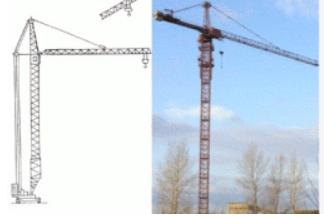
General information
Brand (type) KB - 503
Weight, kg 90,000
OKP code 483542
Specifications
Carrying capacity (max.), T 28
Technical characteristics Type - mobile on a rail track with a rotary tower and a beam boom. Crane execution - 503. Load moment - 280 tm. Lifting height, maximum - 67.5 m.With horizontal boom - 53 m., Maximum reach - 40 m, minimum - 7.5 m. Lifting capacity with horizontal boom - 10 tons. Track and base - 7.5 m. Power of electric motors when two mechanisms are in operation - 85.5 kW. Constructive weight - 90 t
Application Designed for the construction of residential, public and industrial multi-storey buildings and structures.
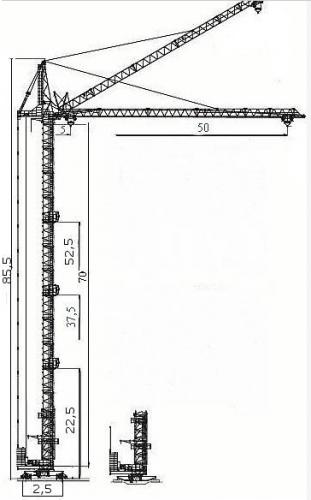
General information
Brand (type) KB - 515
Weight, kg 166 600
Manufacturers Kokhomskiy plant "Strommashina"
OKP code 45354210
Specifications
Carrying capacity, t 10
Technical characteristics Load moment - 160 tm. Carrying capacity at max. departure - 6 tons. Lifting capacity raised by 30 degrees. - 6 t. Departure of an arrow - 40 m. Departure of an arrow raised by 30 degrees. - 35 m. Structural weight - 98.6 tons. Counterweight on the turntable - 65 tons. Counterweight on the spacer - 3 tons. Operating conditions from -40 degrees. up to +40 deg. Seismicity up to 6 points
Application KB-415 is intended for mechanization of work on the construction of buildings up to 95 m in height with a mass of mounted elements up to 10 tons. Provides an outreach up to 50 m.
Description The crane has an upper tower build-up by means of hydraulic equipment of the mounting sleeve. Installation and dismantling of the crane is carried out with a downy boom with the possibility of connecting the boom sections during the installation process when working in cramped conditions. During construction, the driver's cab can be moved to fixed positions using a mounting clip. The electrical equipment of the crane is installed on a turntable in the equipment cabin. Stationary installation of the crane is possible (on supports)
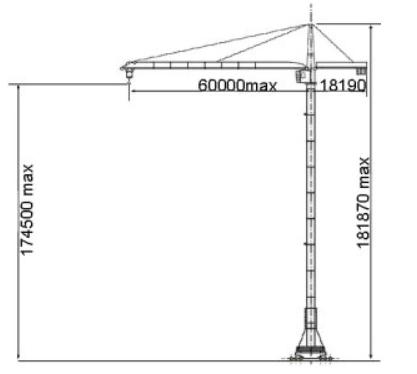
General information
Brand (type) KB - 581
Manufacturers JSC "Mechanical plant" (St. Petersburg)
OKP code 483542
Specifications
Carrying capacity (max.), T 10
Technical characteristics Load moment 180 - 300 tm. Carrying capacity at max. departure - 3 tons. Lifting height, maximum - 56.8 m. Load lifting speed 10 tons - 30 s; up to 2.5 t - 90 s. Boom outreach 50 - 60 m. Base 6x6 m / m.
Application Tower crane KB-581 is intended for the mechanization of construction and installation works during the construction of residential, civil and industrial buildings and structures up to 25 floors with elements building structures weighing up to 10 tons
Description Tower crane KB-581 with an upper swing with a boom reach of up to 60 meters is produced in mobile and stationary versions. KB-581 differs from its predecessors in better mobility and carrying capacity, it is easily transported and assembled on site (all units correspond to the permitted dimensions). The installation uses an original system of hydraulic trimming and fastening of units. The mobility of the KB-581 tower crane makes it possible to reduce the time of its preparation for work by 1.5 - 2 times. Tower crane KB-581 is available in six versions. Manufacturer's warranty - 5 years
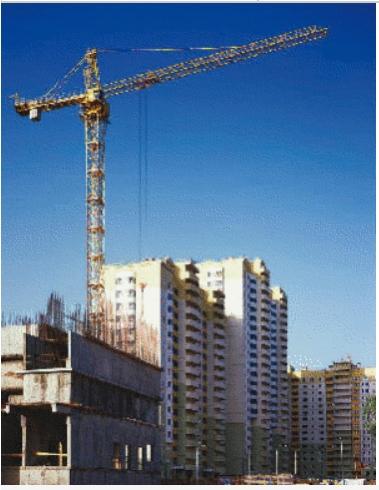
General information
Brand (type) KB - 585
Manufacturers Kokhomskiy plant "Strommashina"
OKP code 45354210
Specifications
Carrying capacity, t 10
Technical characteristics Load moment - 260 tm. Carrying capacity at max. departure - 6 tons. Lifting capacity raised by 30 degrees. - 6 t. Boom outreach - 40 m. Minimum outreach - 4 m. Lowering depth - 5 m. Structural weight - 74.3 t. Counterweight weight - 14.5 t. Operating conditions from -40 to +40 degrees. Seismicity up to 6 points
Application KB-585 is intended for the mechanization of work on the construction of buildings up to 66 m in height in a free-standing version up to 160 m in an attached version with a mass of mounted elements of 10 tons
Description Tower crane, top-slewing, with a block boom providing an outreach of up to 60 m. The crane is installed on a specially prepared foundation and is fastened by means of special inventory anchors. The crane has an upper extension of the tower with the help of hydraulic equipment of the mounting cage. Fastening of the crane to the building is carried out by means of an inventory covering frame and fastening rods (manufactured according to a separate project). The fastening step is 30 m. Installation and removal of the covering frames of the fastening in the design position is carried out with a mounting clip. A mounting jib with a lifting capacity of 1.5 tons is provided on the head of the crane for the convenience of mounting and dismounting the fastening rods. The electrical equipment of the crane is installed on a turntable in the equipment cabin
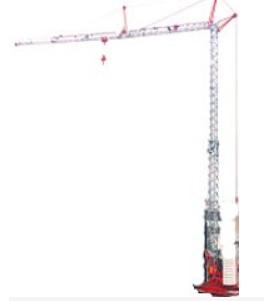
General information
Brand (type) KB-314
GOST, TU TU 4835-007-00239913-08
Length, mm 16 500
Width, mm 2 500
Height, mm 4,000
Manufacturers JSC "Nyazepetrovsk plant of construction machines"
OKP code 4835421048
Specifications
Carrying capacity (max.), T 5
Technical characteristics Lifting height with a horizontal boom - 21/27 m. Lifting height with an inclined boom (20 degrees) - 41.7 m. Boom outreach with a horizontal boom - 43 m. Boom outreach when raised by 20 degrees. boom - 40 m.Carrying capacity at the end of the boom - 1 ton
Application Crane without hydraulics, operated up to - 40 degrees C. It is transported on trolleys or a low loader trawl in transport dimensions
Description The crane can be operated in I-III wind regions. With the installation of an additional central ballast (16 tons), the crane can be operated in I-V wind districts
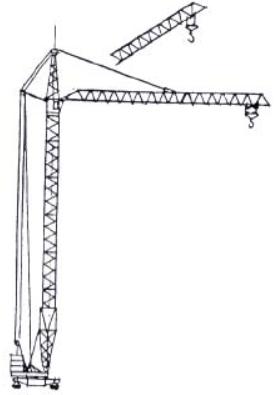
General information
Brand (type) KB-403A
GOST, TU TU-22-4522-79
Weight, kg 50,000
Manufacturers JSC "Nyazepetrovsk plant of construction machines"
OKP code 4835421048
Specifications
Carrying capacity, t 20
Technical characteristics Type - mobile on a rail track with a rotary tower and a beam boom. Execution of the crane with a boom length - 30 m. Load moment - 160 tm. The maximum lifting height is 49.6 m. With a horizontal boom - 41 m. The maximum reach is 25 m. The minimum is 5.5 m. The maximum lifting capacity with a horizontal boom is 8 tons. With a maximum reach - 8 m. The track is 6 m. The power of the electric motors during the operation of two mechanisms is 85 kW. Total installed power - 116 kW
Application Designed for the mechanization of the construction of residential, administrative and industrial buildings up to 16 floors high with a mass of mounted elements up to 8 tons.
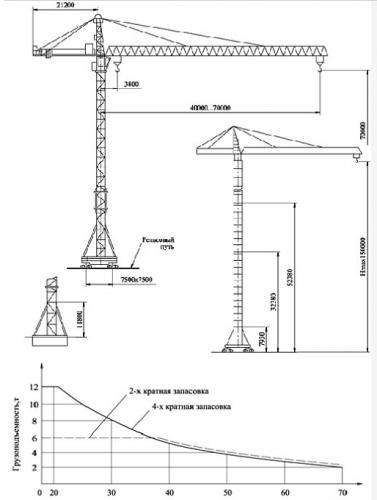
General information
Brand (type) KB-571B
Weight, kg 118 000
Manufacturers JSC "Rzhevsky Crane Building Plant"
OKP code 483542
Specifications
Carrying capacity (max.), T 12
Technical characteristics Load moment - 250 tm. Lifting capacity at maximum outreach - 2.6 t. Outreach: maximum - 70 m; at maximum lifting capacity - 20.8 m. Load lifting speed 0-90 m / min; movement of the cargo cart 0-60 m / min; crane movement - 16 m / min. Rotation frequency - 0.7 rpm. Track x Base - 7.5 m. Total weight - 250 t
Application Tower crane KB-571B is intended for the mechanization of construction and installation works during the construction of residential, civil and industrial buildings and structures of various storeys with building structural elements weighing up to 12 tons
Description The KB-571B overhead swing crane with a boom reach of up to 70 meters is available in mobile and stationary versions. The crane uses original control systems for mechanisms with extensive use of modern purchased products, including imported ones. The crane control system is complex, fulfills the functions of safety requirements, a parameter recorder and a coordinate protection device for the crane operation zones
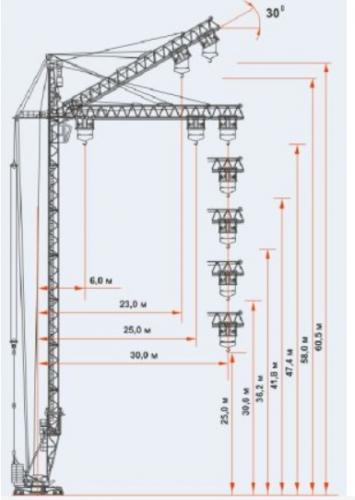
General information
Brand (type) KBM-401PA
Manufacturers JSC "Rzhevsky Crane Building Plant"
OKP code 483542
Specifications
Carrying capacity, t 10
Technical characteristics Type - mobile (rail-mounted) full-revolving (with a rotary tower). Track - 6 m. The radius of curvature of the inner rail for a curved section of the track - 10 m. Engine types - MKAF 225L6 U1, MTKN 412-4 / 24 U1. Power - 55 kW. Rotation frequency - 975 rpm. Lifting and lowering speed, load up to 2.5 tons - 45 m / min., Load over 2.5 tons - 30 m / min. Smooth landing speed, max. mass, no more - 4.8 m / min. Power consumption - 67 kW
Application Designed for the mechanization of lifting and transport operations in the construction of residential, civil and industrial buildings and structures of various storeys with elements of building structures. It is used for work in I-VI wind regions in accordance with GOST 1451-77 and in a climatic version "U" category I in accordance with GOST 15150-69 at an ambient temperature of - 40 degrees. up to +40 deg. Seismicity up to 6 points inclusive. Group of operating mode of the crane A4 according to ISO 4301 / 1-86. Rear clearance - 4.2 m. Weight of counterweight plates - 50.05 tons. Mobile self-erecting tower crane KBM-401P
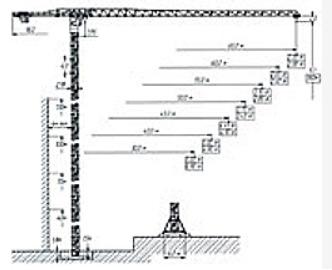
General information
Brand (type) KB-586
GOST, TU TU 4835-008-00239913-10
Manufacturers JSC "Nyazepetrovsk Crane Building Plant"
OKP code 4835421760
Specifications
Carrying capacity, t up to 10 t
Technical characteristics Maximum load moment - 212.75 tm. Carrying capacity - 5 tons (with a 2-fold reserve), 10 tons (with a 4-fold reserve). Departure max. - 65 m. Lifting height (on a reinforced base) - 64 (72) m. Permissible wind speed - 20 m / s. The angle of rotation is not limited. Operating conditions from -40 to +40 C. Control system - frequency regulation
Application Tower crane KB-586 is intended for the mechanization of construction and installation work during the construction of residential, civil and industrial buildings and structures of increased number of storeys with a mass of mounted elements up to 10 tons
Description KB-586 is a construction stationary attachment headless electric hook-on crane with a fixed tower and a full-revolving beam boom equipped with a cargo trolley. The height of a freestanding crane is 64 (72) m. With an increase in height, the crane is attached to the building with special ties. The installation of the crane is carried out by the method of building up using a hydraulic mounting device.
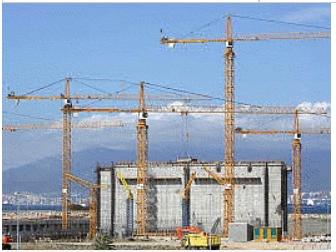
General information
Brand (type) 132 EC-N
Manufactured by Liebherr-Rusland LLC
OKP code 45354210
Specifications
Carrying capacity, t 8
Max. lifting height, m 72.2
Technical data Lifting capacity at max. departure - 1700 kg. Tower - 132 NS
Application Designed for the construction of residential, public and industrial multi-storey buildings and structures in cramped conditions.
Description EC-H cranes are economical to transport, quick and easy to install, and are state-of-the-art in driven equipment. The load class of these cranes covers the needs of medium to large construction projects. The individual components of the crane can be transported in the order in which they are later assembled. These cranes use a modular Liebherr concept and are equipped with an electronic monitoring system (EMS) as standard.
From:
1. Purpose and device of the crane
Tower cranes (Figure 1) are designedto service the territory of construction sites of buildings and structures, warehouses, landfills, loading and unloading materials from transport - when performing construction and installation and loading and unloading operations.In this case, the tower crane makes working movements: changing the reach, raising the boom, turning and moving the crane. Changing the reach of the boom, depending on its type, is done either by raising or lowering the boom, or by moving the cargo cart along the boom.
Figure 1 - Tower crane
The lifting of loads is carried out using a load winch, a load rope and a hook clip. The slewing part of the crane rotates relative to the fixed part by means of the slewing mechanism. They are connected by a support-rotary device (abbreviated OPU), which transfers vertical and overturning loads from the rotary part to the non-rotary - running frame.
The main mechanisms of tower cranes are equipped with special safety devices, called limiters, with which they are equipped: a mechanism for lifting the load, turning the crane, moving the load trolley and lifting the boom. These crane mechanisms are controlled by the crane operator from the control cabin, which is usually installed at the top of the tower structure..
Description and construction
To perform basic operations, the crane is equipped with appropriate mechanisms: winches, blocks and pulleys.
Crane tower general purpose It has either a telescopic structure or a lattice structure of two types: rotary and non-rotary. At high heights, it can be stacked (top) and grown (bottom). A hook suspension is used as the main load-gripping body. Such cranes, in the bulk, are made in a mobile version on a rail track, and their design allows them to quickly mount and dismantle and further transport to another object.
Any tower crane consists of the following parts:
Tower.
Working boom.
Supporting part.
Slewing support device.
Control cabin.
KB-674 - tower hoisting crane(Figure 2), self-propelled, rail-mounted, full-revolving, designed for construction and installation works of the main equipment of the main buildings of open and semi-open layouts, as well as residential and administrative buildings and structures with a mass of mounted elements from 2.5 to 25 tons, refers to cranes of the 6th size group
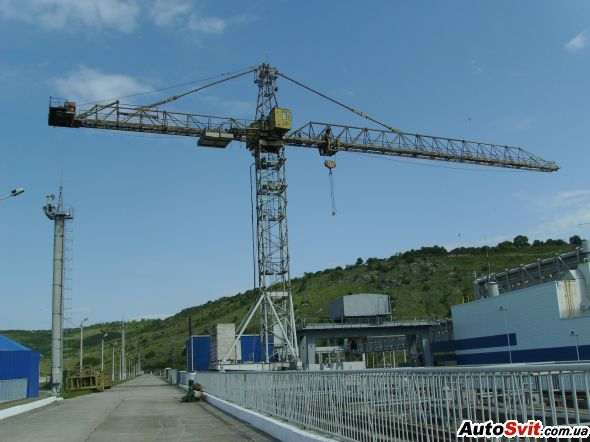
Figure 2 - KB 674
Working boom. As a working boom of a tower crane, a hammer-shaped or suspended boom (with a rigid brace of separate rods, or on a flexible rope suspension) can be used. Structurally, the boom can be a beam, lifting or articulated boom made of pipes (small or large diameter), curved profile or corners. The booms of cranes are made in section, which simplifies assembly and transportation, and also provides versatility of designs
Tower. Crane towers: swivel, extendable, telescopic, swivel. The crane tower is a telescopic (tubular structure made of a large diameter pipe), or a lattice structure made of corners or small diameter pipes.
According to the way of turning, the crane tower can be top-slewing (with a non-rotating tower and a slewing head) and bottom-slewing (with a slewing platform or with a slewing tower).
By the method of assembly, crane towers can be made non-disassembled, disassembled on the ground (telescopic and folding), extended from below and extended from above.
Traveling carriages of mobile rail cranes are divided into driven and non-driven. The bogies are made on steel traveling wheels with flanges, which move along the crane rail track using movement mechanisms
Application
General purpose construction tower cranes, mainly used in civil and industrial construction. Construction cranes for high-rise construction are used for the construction of multi-storey civil and industrial buildings great height(up to 150 m and more).
Table 1- Technical characteristics of tower cranes
|
Carrying capacity, t |
5-25 (up to 75) |
|
Departure, m |
25-40 (up to 80) |
|
Lifting height, m |
up to 90 for mobile (up to 150-220 - for attached) |
|
Speeds: |
|
|
lifting load, m / min |
10-100 |
|
rotation, rpm |
0.2-1.0 |
|
crane movement, m / min |
10-30 |
Work performance and safety guidelines.
1. The cranes can be carried out by the owners of cranes or operating organizations that have a special permit (license) of technical supervision for their operation.Owners of cranes can allocate them for the production of work on orders to other organizations and citizens (entrepreneurs) who have a license to operate cranes or a permit from a technical supervision body to work with cranes.A permit for the production of work by cranes is issued by the technical supervision body to organizations and citizens (entrepreneurs) who have managers, specialists and service personnel trained and tested for knowledge of these Rules and other regulatory legal acts, as well as conditions for the safe production of work.In cases where a crane is allocated to a customer who does not have a license to operate cranes or a permit from a technical supervision authority to carry out work, as well as to an individual, the safety of work with its use must be fully ensured by the owner of the crane.The crane owner must determine the procedure for the allocation and delivery of cranes to customers on the basis of applications of the established form or contracts. Moreover, in these documents responsibilities should be allocated between the owner and the customer to ensure the safety of the work.
2. Cranes in operation must be provided with plates indicating the registration number, rated lifting capacity, the date of the next partial and complete technical survey.
Inscriptions for bridge, cantilever, gantry and tower cranes must be clearly visible from the ground or floor of the workshop. Recommended letter size: height h > 80 mm, width b> 35 mm.
3. The cranes can be allowed to move loads, the mass of which does not exceed the rated carrying capacity.
4. When operating overhead cranes controlled from the cabin, a branded system must be used, in which only a crane operator who has received a key in accordance with the procedure established by the owner is allowed to operate the crane.a brand that includes an electric crane control circuit.
5.When operating cranes operated from the floor, it must be
free passage is provided for the worker operating the crane.
6. Entrances to crane tracks, galleries of overhead cranes in operation must be locked. The admission of personnel serving cranes, as well as other workers to the cranepaths and walk-through galleries of existing pavements and mobilejib cranes for the production of repair or anyother work must be carried out according to a permit-permit that determines the conditions for the safe production of work.
The procedure for issuing a work permit and instructing workers is determined by the owner of the crane. O work ahead must be notified by an entry in the logbook for the crane operators of all span changes, the workshop where the work is performed, and, if necessary, the crane operators of adjacent spans.
- For each workshop (span) not equipped with walk-through galleries along the crane track, where bridge cranes operate,
measures should be developed for the safe lowering of the crane operator from the cab in case of a forced stop of the crane not at the landing site. These measures must be specified in the operating instructions for crane operators.
8.According to the decision of the owner, overhead cranes can be used for the production of construction, painting and other works with
available on the crane sites. Such work must be performed
according to the admission order defining safety measures to prevent a fall from a crane, injury electric shock, exit to
crane tracks, collision of cranes, simultaneous movement
crane and its trolley. Using a crane to move loads
when performing these works from its bridge is not allowed.
9 General purpose cranes equipped with a grab or
magnet, can be allowed to work only when performing
specially designed for these cases, the instructions set out
in the manuals for the operation of the crane and the lifting device.
10. Defective lifting gear and
devices that do not have tags (stamps) should not be located in the places of work. It is not allowed to be in the place of work of unmarked and damaged containers.
11. The owner of the crane or the operating organization should have developed methods for the correct slinging, hooking and storage of goods, which should be trained by the slingers.Slinging schemes, graphic image methods of slinging and hooking loads must be handed over to the slingers and crane operators or hung out at the work sites. The owner of the crane or the operating organization should also develop methods for strapping parts and assemblies of machines moved by the crane during their installation, dismantling and repair, indicating the devices used in this case, as well as methods for safe tilting of goods when such an operation is performed using a crane. Schemes for slinging and tilting loads and a list of used load-handling devices should be given in the technological regulations. The movement of cargo for which no slinging schemes have been developed should be carried out in the presence and under the guidance of a person responsible for safe production. work with cranes. The management of river ports is obliged to ensure the production of loading and unloading operations using cranes according to the technological documentation approved by it.
12. Organizations operating cranes must establish a procedure for the exchange of signals between the slinger and crane operator. Recommended signage is given in Appendix 23. When erecting buildings and structures with a height of more than 36m, two-way radio communication should be used. Signal signaling and signal exchange system for radio communication should be included in manufacturing instructions for crane operators and slingers.In cases where the area served by the crane is not completely visible from the crane operator's cab, and in the absence of betweencrane operator and slinger radio or telephone forsignaling to the crane operator, a signalman must be assignedthe body of the slingers. Such signalmen are appointed by a personresponsible for the safe performance of cranes.
13. The place of production of work on the movement of goods by cranes should be illuminated in accordance with the project for the production of works.
14. The crane owner or operator must:
Develop and issue production projects to the place of work
construction and installation works by cranes, technological maps of cargo storage, loading and unloading Vehicle rolling stock and other technological regulations;
To acquaint (under signature) with projects and other technological regulations of persons responsible for safe production ra bot cranes, crane operators and slingers;
Provide slingers with distinctive signs (red bandages on the sleeves, clearly visible to the crane operator), means individual protection(safety helmet of the established sample), tested and marked with removable load-gripping devices and containers corresponding to the mass and nature of the goods being transported;
Post a list of the main cargo transported by the crane at the place of work, indicating their weight. For crane operators and slingers servicing self-propelled jib cranes during construction and installation work, such a list should be handed out;
Ensure that the load test is carried out on the load limiter within the timeframes specified in the crane operating manual and in the passport of the load limiter;
Determine the procedure for the allocation and direction of self-propelled jib cranes to objects at the request of the established form and ensure its observance;
Establish the procedure for sealing and locking the protective panels of tower cranes with a lock, as well as sealing the limiters of the lifting capacity of self-propelled jib cranes;
Determine the sites and places of storage of goods, equip them with the necessary technological equipment and devices and instruct crane operators and slingers regarding the order and dimensions of storage;
Ensure the implementation of projects for the production of work and other technological regulations in the production of work with cranes;
Ensure that the tower cranes that are out of order at the construction site are in good condition. After receiving a message from the customer about the completion of the work (before the start of dismantling), disconnect the crane from the power source and take measures to prevent theft of the crane by the wind.
15. For the safe performance of work on the movement of goods by cranes, their owner and manufacturer of work must ensure that the following requirements are met:
At the place of production of work on the movement of goods, as well as on the crane, it should not be allowed to find persons who are not directly related to the work performed;
The entrance to the overhead cranes and the descent from them should be made through the landing site or, in some cases, through the passage gallery;
If necessary, inspection, repair, adjustment of mechanisms, electrical equipment of the crane, inspection and repair of metal structures dol wives turn off the switch of the input device. This requirement should also be fulfilled when it is necessary to enter the steele overhead crane galleries;
- on overhead cranes, in which the rails of the cargo carriage are located at the level of the gallery deck, before the service personnel exit to the gallery, the cart should be installed in the immediate vicinity of the exit from the cab to the deck.Construction and installation work should be carried out according to the project for the production of works by cranes, which should provide for:
Compliance of the installed cranes with the conditions of construction and installation works in terms of lifting capacity, lifting height and outreach (load characteristic of the crane);
Ensuring safe distances from networks and overhead power lines, places of movement of public transport and pedestrians, as well as safe distances for cranes to approach buildings and places where construction parts and materials are stored;
Conditions for the installation and operation of cranes near the slopes of the excavations; conditions safe work several cranes on one track and on parallel tracks;
The list of used load-handling devices and a graphic image (diagram) of cargo slinging;
Places and dimensions of storage of goods, access roads; measures for the safe production of work, taking into account the specific conditions at the site where the crane is installed, as well as other safety measures provided for by SNiP.
Loading and unloading operations and warehousing of goods at bases, warehouses, sites should be carried out according to technological maps, developed taking into account the requirements of GOST 12.3.009-76 "Occupational safety standards. Loading and unloading works. General requirements security "and approved in the prescribed manner:it is not allowed to lower the load onto the car, as well as lift the load when there are people in the body or cabin of the car. In places of constant loading and unloading of cars and gondola cars, flyovers or hinged platforms for slingers should be installed. Loading and unloading of gondola cars with hook cranes should be carried out according to the technology approved by the manufacturer of the work, which should determine the location of the slingers when moving goods, as well as the possibility of you course them to flyovers and hinged platforms. The presence of people in Gondola cars when lifting and lowering loads with a crane is not allowed; the movement of the load should not be carried out when people are under it. The slinger can be foundnear the load during its lifting or lowering, if the load is raised to a height of not more than 1000 mm from the level of the platform;
Slinging of loads must be carried out in accordance with cxe we slinging. For slinging the load intended for lifting, slings should be used that correspond to the mass and nature of the load being lifted, taking into account the number of branches and their angle of inclination; general-purpose slings should be selected so that the angle between their branches does not exceed 90 degrees;
The movement of small-piece loads should be carried out in a specially designed container, while the possibility of falling out of individual loads must be excluded. It is allowed to lift bricks on pallets without fencing during loading.and unloading (on the ground) vehicles;
The movement of a load, the mass of which is unknown, should be carried out only after determining its actual mass;
Load or load handling device when they are horizontalwhen moving, they must be previously lifted 500 mm higher than objects on the way;
When moving a boom self-propelled crane with a load, the position of the boom and the load on the crane must be set in accordance with the crane operating manual;
It is allowed to lower the load to be moved only to the place designated for this, where the possibility of falling, overturning or sliding of the load to be installed is excluded. At the place of installation of the load, pads of appropriate strength must be pre-laid so that the slings can be easily and without damage removed from under the load. It is not allowed to place the load in places not intended for this. Stacking and dismantling of cargo should be carried out evenly, without violating the dimensions established for storage of cargo and without blocking the aisles. Stowage of cargo in gondola cars, on platforms should be carried out in accordance with the established norms in agreement with the consignee. Loading of cargo into cars and other vehicles should be carried out in such a way as to ensure convenient and safe slinging during unloading. Loading and unloading of gondola cars, platforms, cars and other vehicles must be carried out without disturbing their balance;
It is not allowed to find people and carry out any work within the movement of goods by cranes equipped with a grab or magnet. Ancillary workers servicing such cranes may be allowed to perform their duties only during breaks in the operation of the cranes and after the grab or magnet has been lowered to the ground. Places of work with such cranes should to be fenced and marked with warning signs;
Not it is allowed to use the grab to lift people or perform work for which the grab is not intended;
By at the end of work or during a break, the load should not remain v suspended, and the switch supplying voltage on main trolleys or flex cable must be unplugged and locked. At the end of the work of the tower, portal, gantry crane and overhead loader, the control cabin must be locked, and the crane must be reinforced with all anti-theft devices available on it;
Tilting of loads by cranes should be carried out using special devices (tilters) and in specially designated places. The performance of such work is allowed only according to a previously drawn up technology that determines the sequence of the operation, the method of slinging the load and instructions for the safe production of work;
During the operation of overhead cranes installed in several tiers, the condition for the passage of the cranes of the upper tier must be met above cranes located below, only without load with the hook raised to the upper working position;
When lifting a load, it must be previously raised to a height of no more than 200-300 mm to check the correct slinging and reliability of the brake;
When lifting a load installed near a wall, column, pile, railway carriage, machine tool or other equipment, people should not be allowed to stay between the load being lifted. and specified building parts or equipment; this requirement must also be met when lowering and moving the load.
16. When operating the crane, it is not allowed:
Entrance to the crane cabin while it is moving;
Finding people near a working self-propelled jib crane in order to avoid being pinched between the slewing and non-rotating parts of the crane;
Moving a load that is in an unstable position or suspended by one horn of a two-horned hook;
Moving people or cargo with people on it. Lifting of people with bridge-type cranes can be carried out in exceptional cases provided for by the operating manual.of the crane, and only in a specially designed and manufactured cabin after the development of measures to ensure the safety of people. Such work should be carried out according to special instructions agreed with the technical supervision authorities;
Lifting a load covered with earth or frozen to the ground, laid with other loads, reinforced with bolts or in any other way, filled with concrete, as well as metal and slag frozen in a furnace or welded after being drained;
Pulling the load on the ground, floor or rails with a crane hook when the cargo ropes are inclined without the use of guide blocks that ensure the vertical position of the cargo ropes;
Release by a crane of slings, ropes or chains pinched by the load;
Pulling the load during lifting, moving and lowering. For turning long and bulky goods during their movement, hooks or guy wires of appropriate length should be used;
Leveling of the transported load by hand, as well as the correction of slings by weight;
Delivery of cargo to window openings, balconies and loggias without special receiving areas or special devices;
The use of limit switches as working bodies for automatic stopping of mechanisms, except for the case when the overhead crane approaches the landing site arranged at the end of the building;
Work with disconnected or faulty devices safety and brakes;
Switching on the crane mechanisms when people are on the crane outside its cabin. An exception is allowed for persons inspecting and adjusting mechanisms, electrical equipment and safety devices. In this case, the mechanisms must be turned on at the signal of the person performing the inspection;
Lifting the load directly from the place of its installation with a boom winch, as well as with boom lifting and telescoping mechanisms;
Landing in a container lifted by a crane and finding people in it;
Finding people under the crane boom when lifting and lowering it without load.
17. The performance of work with self-propelled jib cranes at a distance of less than 30 m from the lifting retractable part of the crane in any of its position, as well as from the load to the vertical plane formed by the projection on the ground of the nearest wire of the overhead power transmission line, which is energized more than 42V, should be carried out along -tolerance determining safe conditions work.
The procedure for organizing the production of work near the power transmission line, issuing a work permit and instructing workers should be established by orders of the owner of the crane and the manufacturer of the work. The safety conditions specified in the permit must comply with GOST 12.1.013-78 "Occupational Safety Standards. Construction. Electrical Safety. General Requirements". The validity period of the permit is determined by the organization that issued the order. The permit must be handed out to the crane operator before starting work. The crane operator is prohibited from unauthorized installation of a crane to work near a power line, as an entry is made in the waybill.
The work of the crane near the power line must be carried out under the direct supervision of the person responsible for the safe operation of the cranes, who must also indicate to the crane operator the place of installation of the crane, ensure that the working conditions stipulated by the work permit are met and make an entry in the crane operator's logbook about the work permit.
When performing work in the security zone of the power transmission line or within the gaps established by the rules for the protection of high-voltage electrical networks, the work permit can be issued only with the permission of the organization operating the power line.
When self-propelled jib cranes are operating at operating power plants, substations and power lines, if work with the use of cranes is carried out by personnel operating electrical installations, and the crane operators are on the staff of the energy organization, a work permit for work near energized wires and equipment is issued in accordance with the procedure established by the industry norms.
The operation of self-propelled jib cranes under non-disconnected contact wires of urban transport can be carried out provided that the distance between the crane boom and the contact wires is at least 1000 mm when installing a limiter (stop), which does not allow reducing the specified distance when lifting the boom.
The order of operation of cranes near a power line made with a flexible cable is determined by the owner of the line.






